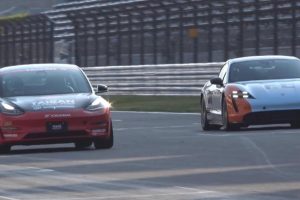- 🚫 The NHTSA has closed its investigation (EA22002) into Tesla Autopilot, which aimed to assess the performance of the system.
- 🔍 However, the agency has opened a new Recall Query (RQ24009) to evaluate the effectiveness of Tesla’s Autopilot remedy (23V-838) rolled out in December 2023.
- 🚨 The NHTSA identified at least 13 crashes involving fatalities and serious injuries, where driver misuse of Autopilot played an apparent role.
- 📢 The agency has concerns about post-remedy crash events, preliminary test results of remedied vehicles, and the fact that drivers can opt-out of the remedy.
- 🌊 The investigation found trends in crashes, including collisions with adequate time for an attentive driver to respond, inadvertent Autosteer disengagement, and roadway departures in low traction conditions.
- ⚠️ Tesla’s Autopilot is a Level 2 system that still requires driver attention and readiness to take over in any circumstance, as the car is not fully autonomous.
The National Highway Traffic Safety Administration (NHTSA) has been closely monitoring Tesla’s advanced driver assistance system, Autopilot, and the latest developments suggest that the agency’s scrutiny is far from over. While the NHTSA has closed its investigation (EA22002) into the performance of Autopilot, it has simultaneously opened a new Recall Query (RQ24009) to evaluate the effectiveness of Tesla’s recent remedy aimed at increasing driver attentiveness.
The Catalyst: A Concerning Trend
The NHTSA’s initial investigation into Autopilot was prompted by a concerning trend: the agency identified at least 13 crashes involving fatalities and serious injuries, where driver misuse of the Autopilot system played an apparent role. This alarming revelation underscored the importance of ensuring that drivers remain vigilant and attentive while using advanced driver assistance systems (ADAS) like Autopilot.
Tesla’s Remedy Under the Microscope
In response to the NHTSA’s findings, Tesla rolled out a recall (23V-838) in December 2023, which included an Over-the-Air (OTA) update aimed at increasing driver attentiveness. The update introduced several measures, such as more prominent visual alerts, simplified Autosteer engagement and disengagement, additional checks upon engaging Autosteer, and eventual suspension of the feature if drivers repeatedly fail to demonstrate sustained driving responsibility.
However, the NHTSA is not yet convinced of the remedy’s effectiveness. The agency has expressed concerns about post-remedy crash events, preliminary test results of remedied vehicles, and the fact that drivers have the option to opt-out of the remedy or reverse its effects.
The Underlying Issue: Driver Responsibility
At the heart of the matter lies a fundamental truth: Tesla’s Autopilot is a Level 2 ADAS, which means that it is not a fully autonomous system. While Autopilot can assist with various driving tasks, it still requires the driver’s attention and readiness to take over control in any situation.
The NHTSA’s investigation revealed trends in crashes that could have been avoided or mitigated by an attentive driver. These trends included collisions where the Tesla had adequate time to respond, inadvertent Autosteer disengagement due to driver inputs, and roadway departures in low traction conditions.
The Road Ahead
As the Recall Query unfolds, the NHTSA will undoubtedly scrutinize Tesla’s remedy and its impact on driver attentiveness. The agency’s concerns highlight the need for continued education and awareness campaigns to ensure that drivers understand the capabilities and limitations of ADAS systems like Autopilot.
Ultimately, the responsibility lies with drivers to remain vigilant and engaged while using these advanced technologies. Tesla and other automakers must prioritize safety and emphasize the importance of driver attentiveness, even as they continue to push the boundaries of autonomous driving.





